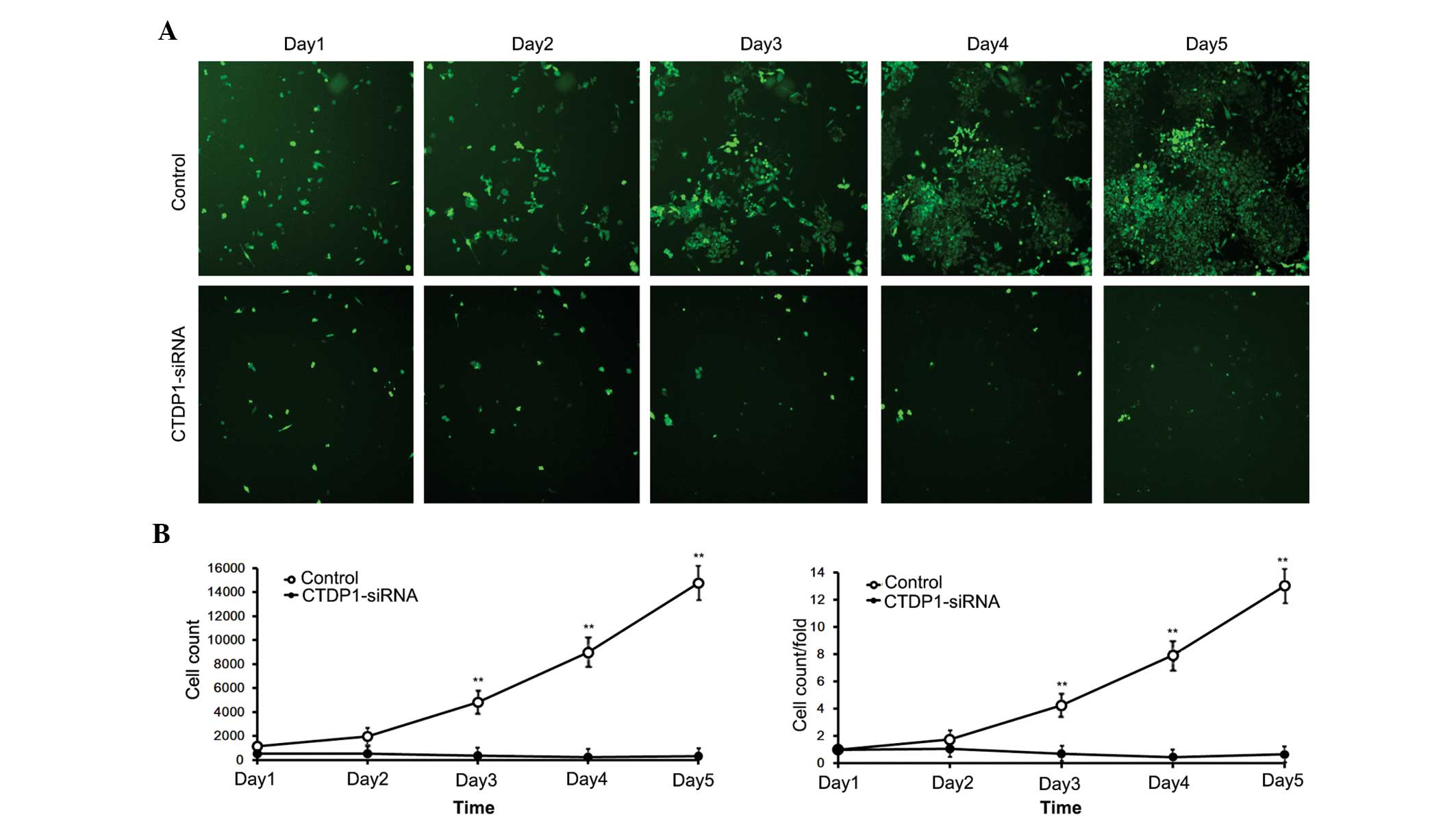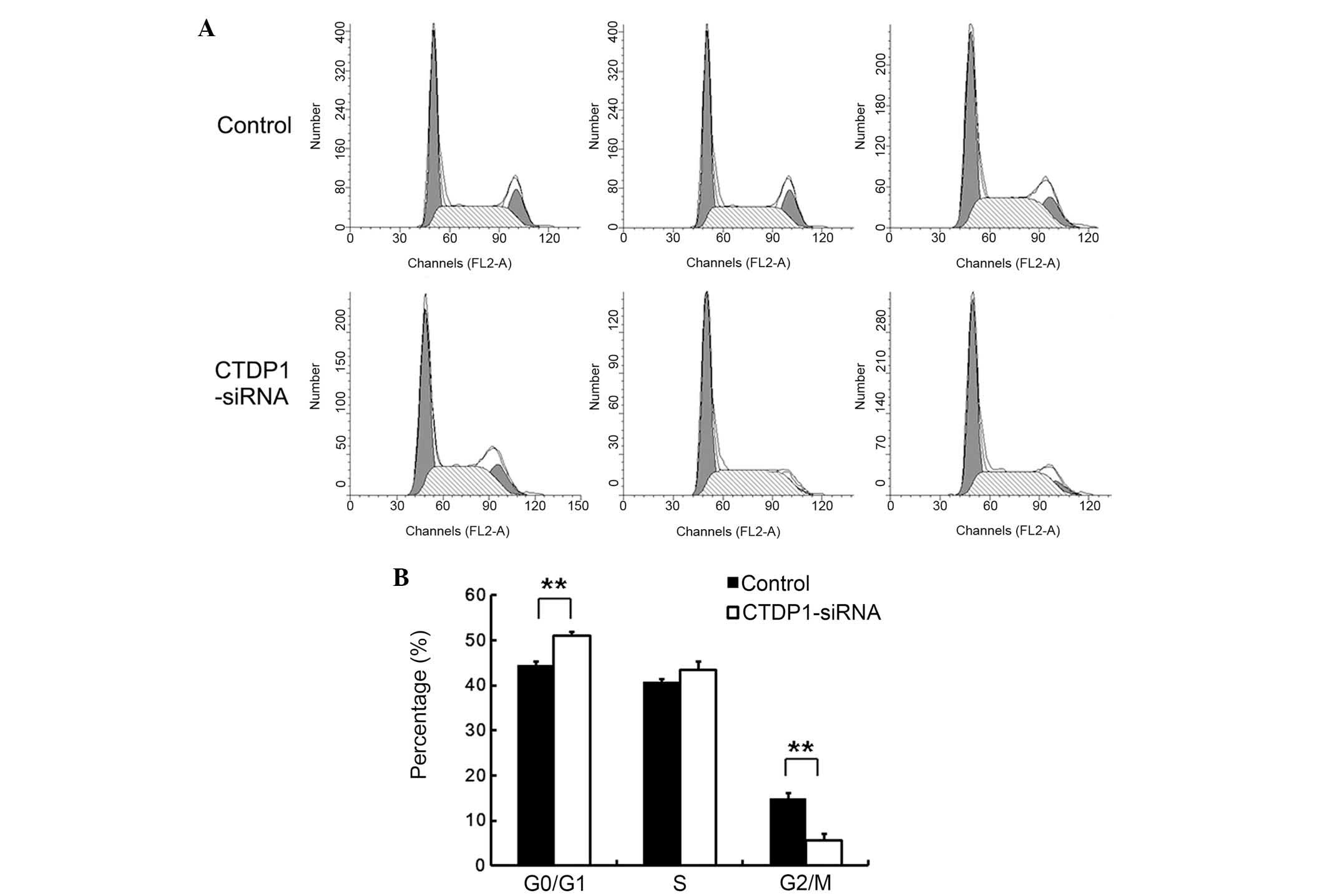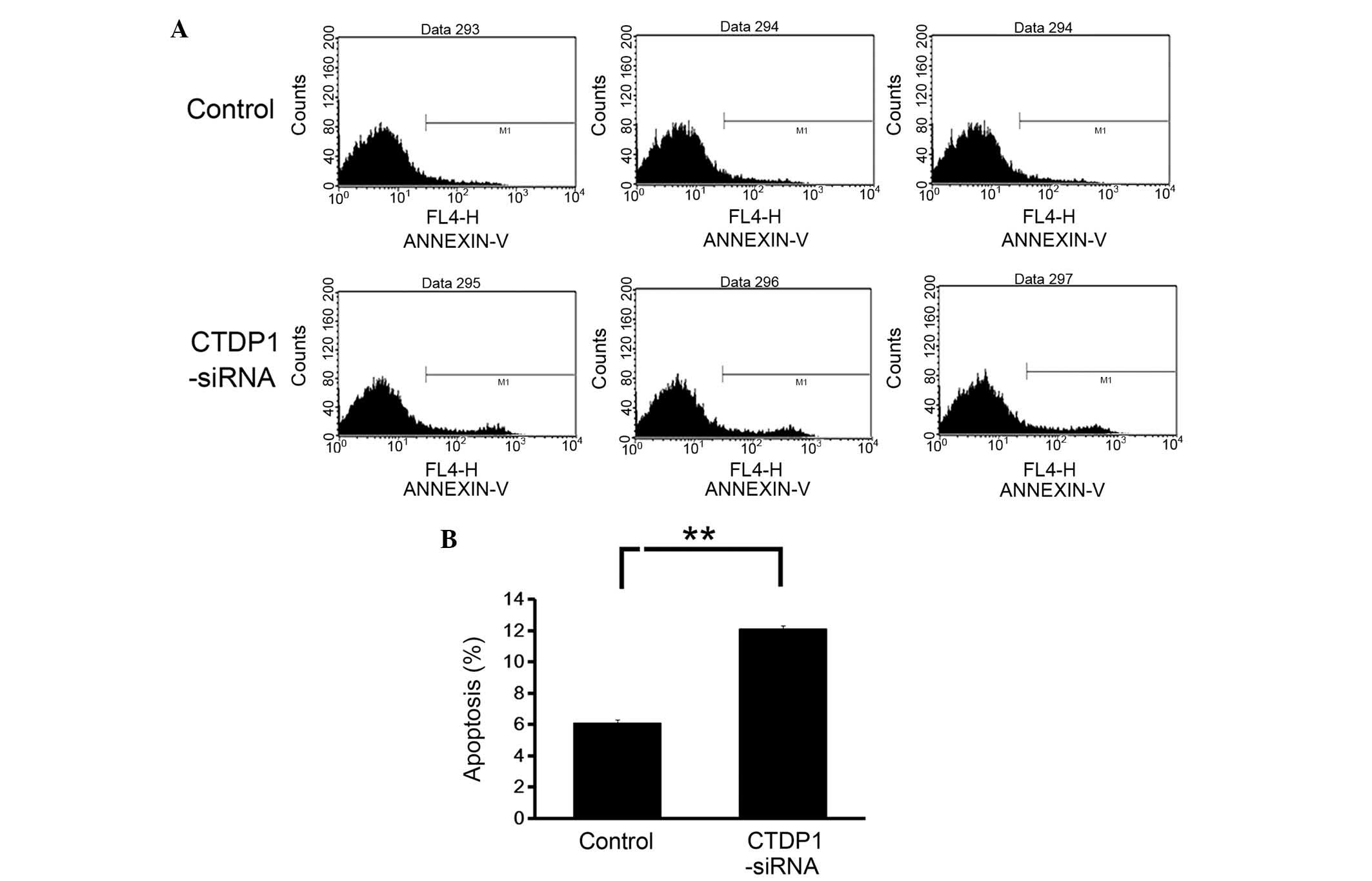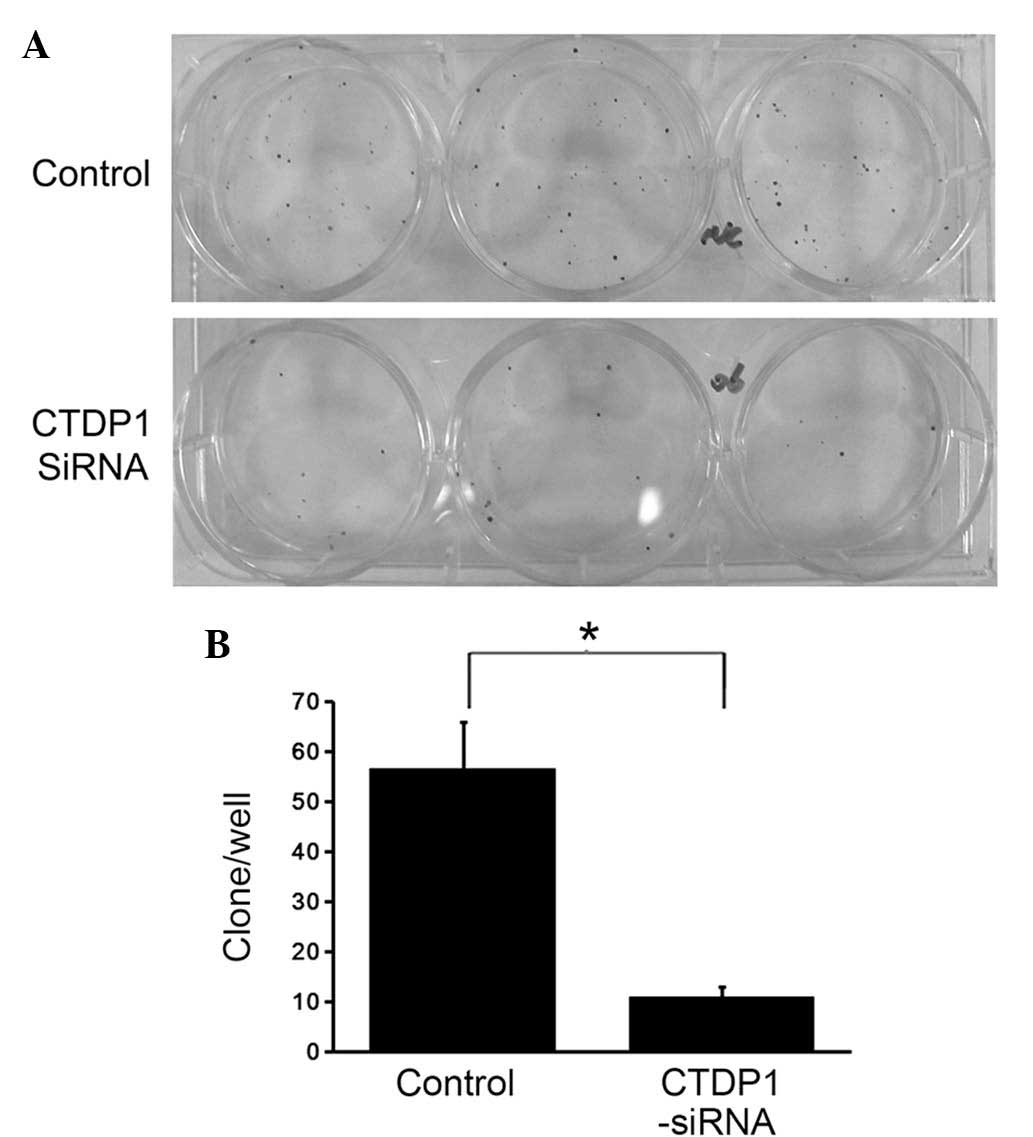Carboxy‑terminal domain phosphatase 1 silencing results in the inhibition of tumor formation ability in gastric cancer cells
- Authors:
- Hongbing Fu
- Dejun Yang
- Changming Wang
- Jiapeng Xu
- Weimin Wang
- Ronglin Yan
- Qingping Cai
View Affiliations
Affiliations: Department of Gastrointestinal Surgery, Shanghai Changzheng Hospital, Second Military Medical University, Shanghai 200003, P.R. China
- Published online on: September 10, 2015 https://doi.org/10.3892/ol.2015.3693
-
Pages:
2947-2952
Metrics: Total
Views: 0 (Spandidos Publications: | PMC Statistics: )
Metrics: Total PDF Downloads: 0 (Spandidos Publications: | PMC Statistics: )
This article is mentioned in:
Abstract
Gastric cancer (GC), one of the most malignant types of cancer, is the second greatest cause of cancer‑associated mortality worldwide. Novel therapeutic targets for GC treatment are therefore urgently required. Carboxy‑terminal domain phosphatase 1 (CTDP1) has a crucial role in the regulation of gene expression. However, to the best of our knowledge, the role of CTDP1 in GC has not previously been explored. In the present study, reverse transcription‑quantitative polymerase chain reaction analysis was used to detect CTDP1 messenger RNA expression in various GC cell lines. CTDP1 was subsequently silenced in GC cells by lentivirus‑mediated small interfering RNA (siRNA) infection, and the effects of CTDP1 inhibition on cell proliferation were evaluated by cell number counting, cell cycle analysis with propidium iodide staining and fluorescence‑activated cell sorting (FACS) analysis, apoptotic rate with Annexin V staining and FACS analysis, as well as colony formation assay in GC cells. The results revealed that CTDP1 was highly expressed in certain GC cell lines and lentivirus‑mediated siRNA infection was able to effectively silence CTDP1 expression in GC cells. CTDP1 inhibition decreased cell proliferation, arrested the cell cycle at G0/G1 phase and increased cell apoptosis in GC cells. Furthermore, the colony formation ability of GC cells was also suppressed by silencing CTDP1. Taken together these results indicated that CTDP1 has a significant role in the tumor formation ability of GC cells and is a novel and promising therapeutic target for the treatment of GC.
View References
|
1
|
Torpy JM, Lynm C and Glass RM: JAMA
patient page. Stomach cancer. JAMA. 303:17712010. View Article : Google Scholar : PubMed/NCBI
|
|
2
|
Siegel R, Ma J, Zou Z and Jemal A: Cancer
statistics, 2014. CA Cancer J Clin. 64:9–29. 2014. View Article : Google Scholar : PubMed/NCBI
|
|
3
|
Jang BG and Kim WH: Molecular pathology of
gastric carcinoma. Pathobiology. 78:302–310. 2011. View Article : Google Scholar : PubMed/NCBI
|
|
4
|
Chambers RS and Dahmus ME: Purification
and characterization of a phosphatase from HeLa cells which
dephosphorylates the C-terminal domain of RNA polymerase II. J Biol
Chem. 269:26243–26248. 1994.PubMed/NCBI
|
|
5
|
Maniatis T and Reed R: An extensive
network of coupling among gene expression machines. Nature.
416:499–506. 2002. View
Article : Google Scholar : PubMed/NCBI
|
|
6
|
Kalaydjieva L: Congenital cataracts-facial
dysmorphism-neuropathy. Orphanet J Rare Dis. 1:322006. View Article : Google Scholar : PubMed/NCBI
|
|
7
|
Varon R, Gooding R, Steglich C, Marns L,
Tang H, Angelicheva D, Yong KK, Ambrugger P, Reinhold A, Morar B,
et al: Partial deficiency of the C-terminal-domain phosphatase of
RNA polymerase II is associated with congenital cataracts facial
dysmorphism neuropathy syndrome. Nat Genet. 35:185–189. 2003.
View Article : Google Scholar : PubMed/NCBI
|
|
8
|
Proudfoot NJ, Furger A and Dye MJ:
Integrating mRNA processing with transcription. Cell. 108:501–512.
2002. View Article : Google Scholar : PubMed/NCBI
|
|
9
|
Svetlov V and Nudler E: Basic mechanism of
transcription by RNA polymerase II. Biochim Biophys Acta.
1829:20–28. 2013. View Article : Google Scholar : PubMed/NCBI
|
|
10
|
Dahmus ME: Reversible phosphorylation of
the C-terminal domain of RNA polymerase II. J Biol Chem.
271:19009–19012. 1996. View Article : Google Scholar : PubMed/NCBI
|
|
11
|
Jasnovidova O and Stefl R: The CTD code of
RNA polymerase II: A structural view. Wiley Interdiscip Rev RNA.
4:1–16. 2013. View Article : Google Scholar : PubMed/NCBI
|
|
12
|
Buratowski S: The CTD code. Nat Struct
Biol. 10:679–680. 2003. View Article : Google Scholar : PubMed/NCBI
|
|
13
|
Bierhoff H, Dundr M, Michels AA and Grummt
I: Phosphorylation by casein kinase 2 facilitates rRNA gene
transcription by promoting dissociation of TIF-IA from elongating
RNA polymerase I. Mol Cell Biol. 28:4988–4998. 2008. View Article : Google Scholar : PubMed/NCBI
|
|
14
|
Visconti R, Palazzo L, Monica R Della and
Grieco D: Fcp1-dependent dephosphorylation is required for
M-phase-promoting factor inactivation at mitosis exit. Nat Commun.
3:8942012. View Article : Google Scholar : PubMed/NCBI
|
|
15
|
Hégarat N, Vesely C, Vinod PK, Ocasio C,
Peter N, Gannon J, Oliver AW, Novák B and Hochegger H: PP2A/B55 and
Fcp1 regulate Greatwall and Ensa dephosphorylation during mitotic
exit. PLoS Genet. 10:e10040042014. View Article : Google Scholar : PubMed/NCBI
|
|
16
|
Schauer T, Tombácz I, Ciurciu A, Komonyi O
and Boros IM: Misregulated RNA Pol II C-terminal domain
phosphorylation results in apoptosis. Cell Mol Life Sci.
66:909–918. 2009. View Article : Google Scholar : PubMed/NCBI
|














